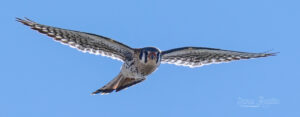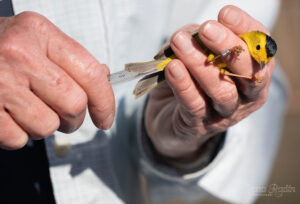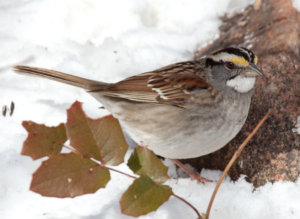As our group approached the Chatfield banding station it was not without some apprehensiveness. The previous day Meredith McBurney, who runs the banding station along with her banding assistants, had recorded only three birds in a five-hour period. Were we going to strikeout and not have any birds in the hand? We could see that only a few cottonwoods were starting to leaf out, insects were apparently in low numbers, and we knew that spring and the spring migrants were running behind schedule due to the recent cold, snowy weather.
The Bird Conservancy of the Rockies has been running the banding station at Chatfield State Park each spring for about thirty years. The process entails using mist nets strung between poles in which birds are harmlessly trapped, they’re removed from the nets, measured and weighed, a small, numbered band is placed on a leg, and then they’re released. Each of these bands has a unique number so that if the bird is recaptured somewhere else, we can know where and when it was banded, thus learning a bit about the timing and route of that species’ migration.
As it turns out luck was with us, and we got to see Meredith band some great birds, a male Wilson’s Warbler, a Black-capped Chickadee, a male and female American Goldfinch, and a male Spotted Towhee. As migrants return to Colorado, we initially have a preponderance of males arriving first to set up territories, and then they will work to attract a mate as the females arrive just a little bit later. There was one other bird at the banding station that we just happened to see hopping around on the ground and low in the bushes, a White-throated Sparrow. The looks we had were world-class, and, as this is predominantly a bird of eastern North America, only occurring rarely in Colorado, we were decidedly thrilled. Also, it doesn’t hurt that these guys are exceedingly handsome with their sharply delineated bright white throat, white supercilium, bright yellow lores (the area between the eye and the bill), and rufous wings.
Leaving the banding station our morning had several other highlights, including five species of corvids: Steller’s Jay, Blue Jay, Woodhouse’s Scrub-Jay, American Crow, and Common Raven. We also picked up on six raptor species: Turkey Vulture, Golden Eagle, Cooper’s Hawk, Bald Eagle, Red-tailed Hawk, American Kestrel, and, last but certainly not least, a Broad-winged Hawk. Broad-winged Hawks are a bird of eastern North America, and they are the smallest North American buteo (soaring hawks) with a wingspread of less than three feet. They occur rarely in Colorado as spring migrants, and we were lucky to get a good view of one soaring overhead.
Good birding!
Chuck
Chatfield Banding Station, May 1, 2021
32 species (+2 other taxa)
Canada Goose 4
Mallard 5
Common Merganser 1
Eurasian Collared-Dove 3
Broad-tailed Hummingbird 1
Double-crested Cormorant 9
Turkey Vulture 2
Golden Eagle 1
Cooper’s Hawk 1
Bald Eagle 2
Broad-winged Hawk 1
Red-tailed Hawk 4
Downy Woodpecker 3
American Kestrel 2
Say’s Phoebe 1
Steller’s Jay 1
Blue Jay 1
Woodhouse’s Scrub-Jay 1
American Crow 3
Common Raven 1
Black-capped Chickadee 12
swallow sp. 2
House Wren 2
American Robin 8
House Finch 2
American Goldfinch 6
White-throated Sparrow 1
Song Sparrow 2
Spotted Towhee 20
Western Meadowlark 2
Red-winged Blackbird 14
Yellow-rumped Warbler 1
Yellow-rumped Warbler (Audubon’s) 2
Wilson’s Warbler 1
View this checklist online at https://ebird.org/checklist/S86819580







Comments
Write Comment